Overview of potato diseases and pests

Potatoes often suffer from attacks from various parasites and diseases. To keep the plants intact and enjoy a good harvest at the end of the season, you need to know how to identify a particular problem in a crop and in what ways you can deal with it. In this article, we will provide a description of the most common potato diseases, as well as talk about ways to combat them and harmful insects.
Diseases and their treatment
Bacterial
Potatoes can be infected with bacterial diseases from the soil, from weeds, as well as from infected tubers. The most common bacterial disease is ring rot. Infected potatoes begin to wither: first, the potato tops wither, then the disease goes lower, eventually affecting the root system. The disease spreads especially actively during the heat. If lower temperatures and high humidity are observed, then the infection spreads more slowly.
They fight this disease by disinfecting the soil and planting resistant varieties - these include varieties such as Rosinka and Skarb.
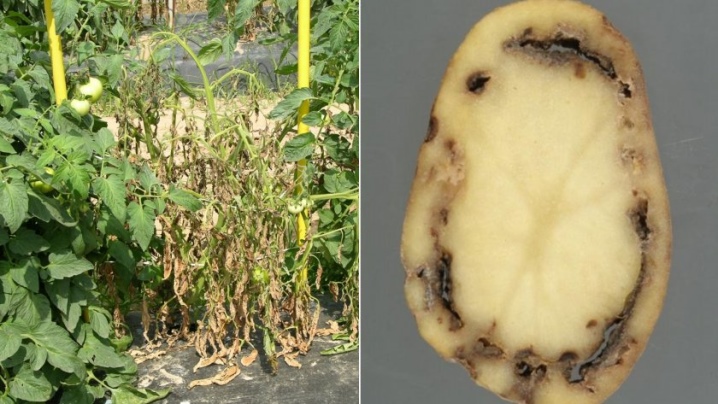
Another common potato disease is brown rot. With it, the affected plants begin to wither, their leaves turn yellow and curl, the zone at the roots rots, and an unpleasant rotten smell emanates from the tubers. To fight this disease, it is necessary to spray the plantings with "Baktofit" before flowering, eliminate weeds, treat the planting material with fungicidal agents, and also dry the fruits before being sent for storage.

Often there is also such a potato disease as black leg. It affects both the tops of the potato and its underground part. The disease progresses especially actively at low temperatures, its main symptoms begin to appear literally immediately: the lower leaves of the potato turn yellow, begin to curl and deform, the stem of the bush begins to turn black and rot. At the final stage of the black leg, the fetus itself is also affected, because of which it begins to rot.
You can get rid of the disease. To do this, it is necessary to spray the bush with a solution of potassium permanganate and sprinkle the soil under it with wood ash.
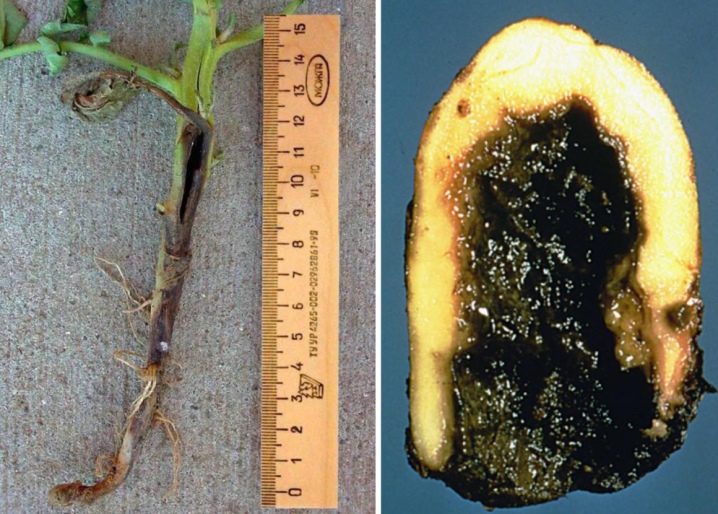
There is another bacterial disease that often affects potatoes, – bacterial cancer. This disease affects potato tubers, penetrating into them through small cracks. At high temperatures and humidity, the disease begins to develop actively, as can be seen from the following symptoms: the stem begins to wither and dry, the root system weakens, and growths can be seen on potato fruits. It is useless to treat this disease, there are no remedies to fight it, but it can be prevented. To do this, you need to be more careful about the choice of planting material, as well as follow the rules of crop rotation.
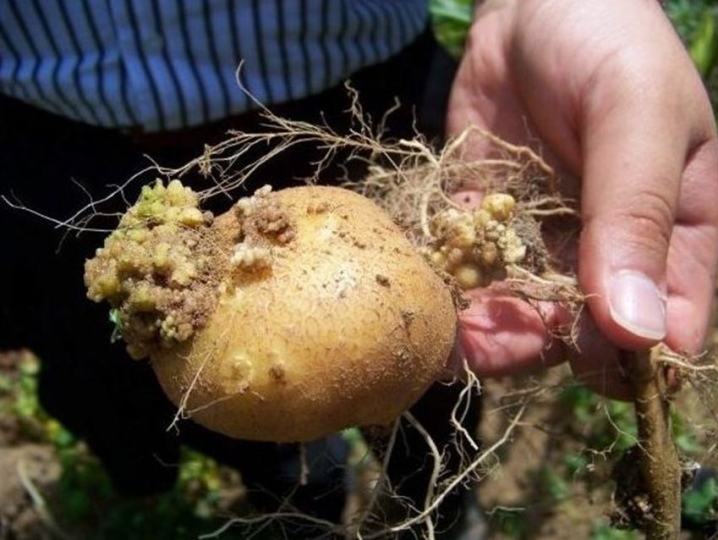
Viral
Viral diseases are among the most dangerous, because they develop quite quickly, they are capable of ruining most of the potato crop in a short time period. Besides, most of the viral diseases are incurable.
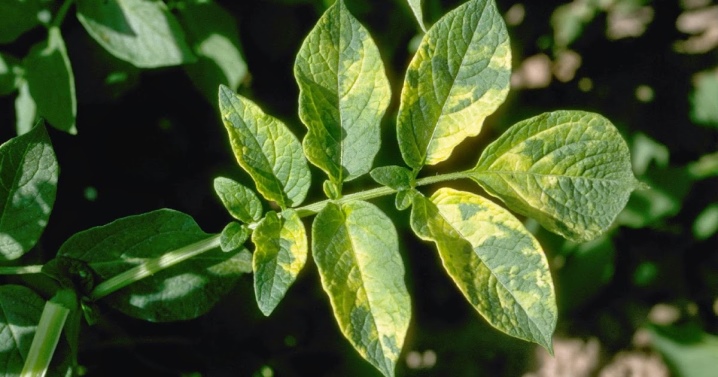
The most common disease is mosaic. This disease has three varieties, but in all cases the virus is spread either by parasites, or the plant becomes infected through contact with other diseased plantings.Moreover, in all three cases, the infection progresses at high temperatures and low humidity.
The first type of mosaic is called speckled. This disease has the following symptoms: light spots are formed on the leaves, the process of photosynthesis is disrupted, and the yield drops sharply.
To prevent it, the plant is treated with such means as "Quadris" or "Revus".
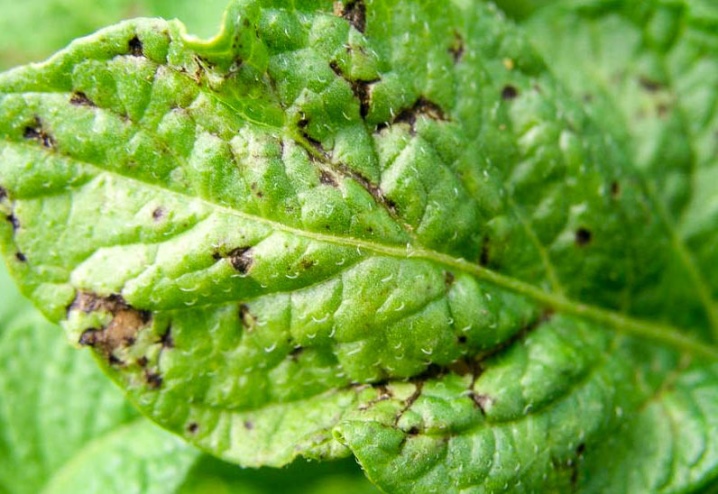
The second variety is called wrinkled mosaic. Bushes that were affected by this disease inhibit growth and development, they do not bloom, they bear poor fruit, and the crop itself is not of high quality. In addition, with a disease, the leaf plate of the plant is also distorted: the leaves brighten, wrinkled areas appear on them, and over time they dry out. To prevent the appearance of wrinkled mosaic, use means such as "Ditan" and "Ridomil".

The third type of this disease is called striped mosaic. Because of it, the stalks of potatoes become more fragile and brittle, and the leaves begin to become covered with specks and stripes. In order to prevent the occurrence of this disease, the plants must be treated with the preparation "Bravo" or "Shirlan".
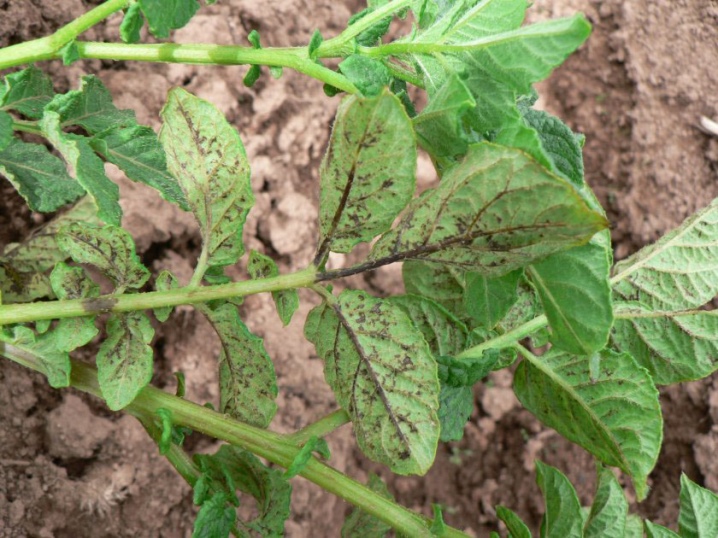
There are other viral diseases as well. These include tuber necrosis... As a rule, potatoes become infected with them from nematodes that live in the ground. You can notice the disease by the following signs: the flowers of diseased bushes are deformed, light specks form on the foliage and stem, and necrosis, stripes and rings of a brownish hue form on the tubers.
There is no cure for this disease. In order to prevent its occurrence, it is necessary to follow the rules of crop rotation.
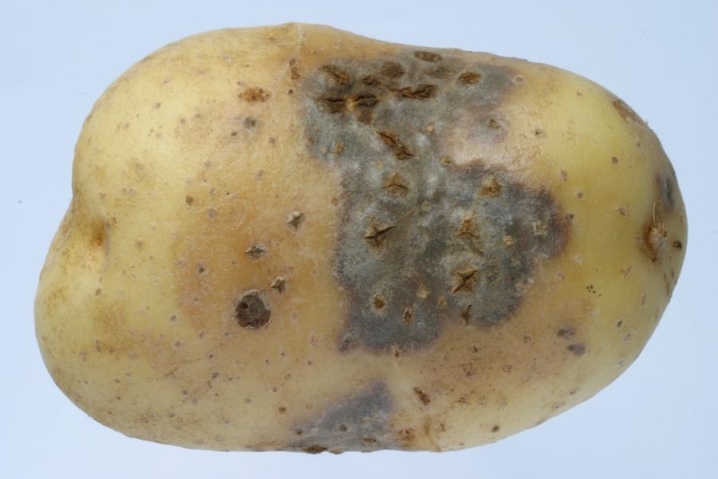
Fungal
Diseases of fungal origin are also dangerous, but most of them are still treated with special drugs.
The most common fungal disease that affects potatoes is black scab. It develops in conditions of high humidity and low temperatures. The disease actively affects both the fruits and the green part of the plant. Sick plantings look weak, brownish ulcers begin to form on their stems, and a white bloom appears near the root. The fruits themselves begin to become covered with dark wart specks. To save the plant from this disease, the culture must be treated with one of the following means: "Ditan M-45", "Kolfugo" or "Mancozeb".
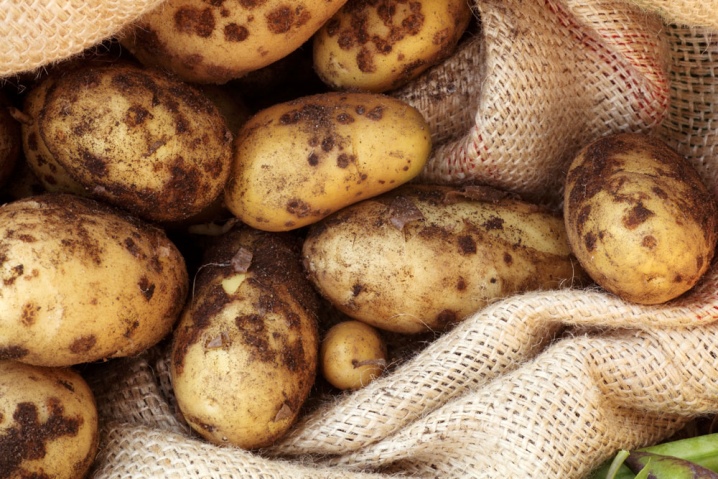
Often, potatoes are also affected by such a disease as late blight, or brown rot, which spreads actively in hot and humid conditions. This disease can be identified by the following signs: brown spots appear on potato stalks and leaf plates, which are often bordered by mold. To treat a plant from late blight, you can resort to using a drug such as "HOM", or a solution of copper sulfate. Treatment with Fitosporin will be no less effective. In addition, for prevention, you can also use a folk remedy based on a liter of milk whey and a couple of drops of iodine. However, it should be noted that it is necessary to fight the disease immediately, at the first stages of its development: if it managed to hit 10% of the ground part, then it will not be possible to stop it.
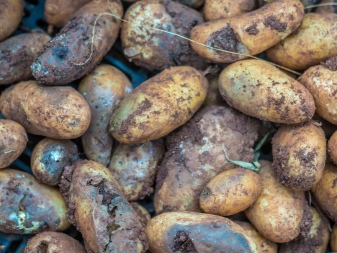

Another common fungal disease that affects potatoes – phomosis. This fungus settles in the tissue of plantings, affecting both the fruit and the stem part. The disease develops especially actively in conditions of high humidity and heat. It can be identified by dark spots with small brownish dots that form on the stem of the plant. At the same time, potatoes begin to grow worse, its shoots become thinner, the leaves become smaller, and ulcers with voids appear on the tubers, in which fungal spores appear.Only preventive measures are effective against this disease, namely: pre-planting treatment of tubers with special means, compliance with the rules of crop rotation, as well as planting disease-resistant varieties.
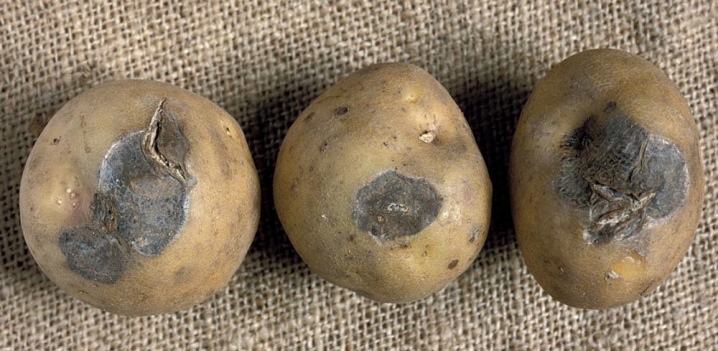
Often, potatoes also affect fusarium, while significantly reducing the number of crops. It is possible to determine the presence of this disease in a plant by the following signs: the leaves of the bush discolor, curl, begin to turn yellow and wither. On the fruits, the disease does not manifest itself so clearly, and therefore, after harvesting the potatoes, it will not be possible to immediately identify the disease. The crop will begin to rot only after a couple of months, while the tissues of the fruit will dry out, and the potatoes themselves will exude an unpleasant aroma. It is impossible to fight this disease, however, the plants can be saved by preventive treatments with Bordeaux liquid and other preparations containing copper sulfate.

Pest control
The most common parasite that attacks potatoes is the Colorado potato beetle. It is a small but noticeable insect, the back of which is covered with reddish stripes. The female of such a parasite is capable of giving birth to 700 larvae in just one season, which actively eat the pulp of the upper leaves of the bush. Adult parasites also intensively feed on the potato bush, which negatively affects both the plant and the quality of its fruits. You can fight this parasite with the help of special means. These include drugs "Coragen", "Colorado", "Apache", "Prestige", "Aktara" and "Commander +". Before using the funds, you must read the instructions for use and the treatment scheme.
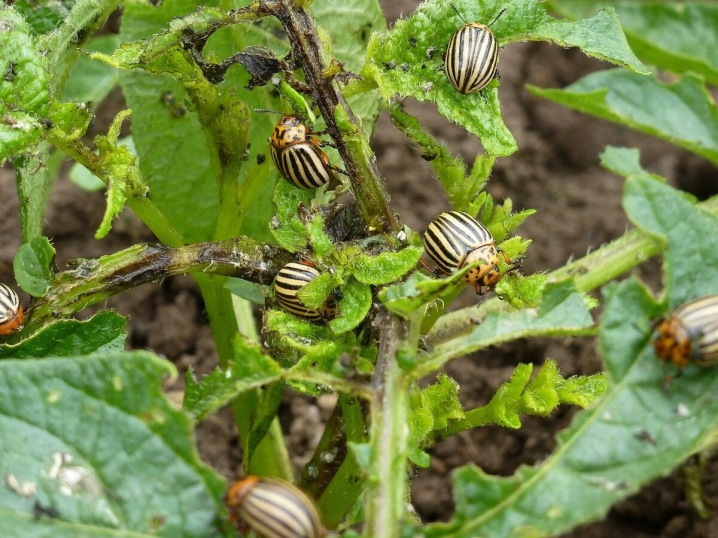
Wireworms also frequently attack potatoes. This parasite is the larva of the click beetle. From a larva to an adult, the parasite develops up to 5 years, during which time it manages to cause great harm to the potato, affecting its young shoots and tubers. This parasite leaves behind holes in the tubers, which is why they subsequently begin to rot. You can fight it with chemicals, which are not recommended during flowering. In addition, you can use folk remedies - for example, a solution based on birch tar. It is not difficult to breed it: a tablespoon of tar must be mixed with 5 liters of water. Before planting, each potato tuber must be dipped in this mixture, which will further scare off the parasite and provide the plant with protection.
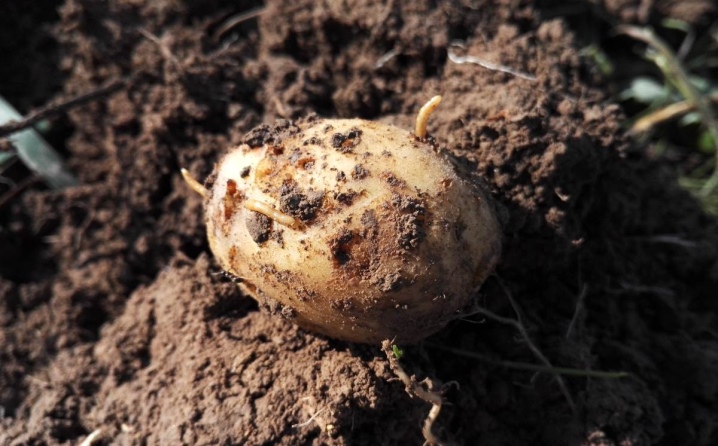
Another pest that actively affects potatoes is the bear. This insect lives in the layers of the earth, which makes it quite difficult to see it. However, you can learn about the appearance of the parasite by the holes that it makes in the ground. The bear does great harm to potato bushes, and not only them, by feeding on the roots of plants, as well as their tops.
You can get rid of the parasite by means of a special solution from a bucket of boiled water and 150 milliliters of kerosene.
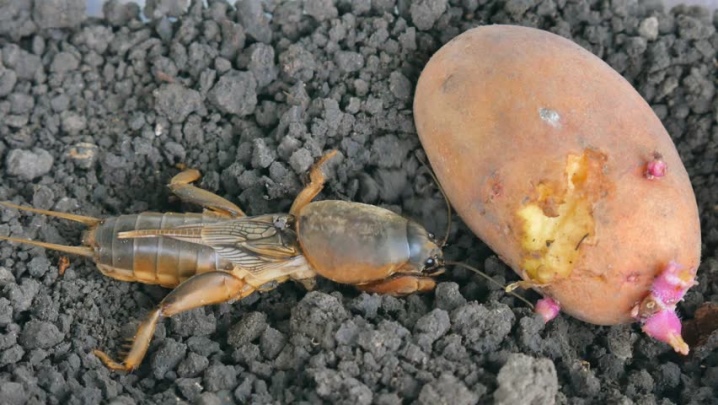
Often the potato also affects the potato flea - a small insect of black, gray, blue or green color, capable of jumping high. Both adults and larvae of this parasite cause harm to plants. Adult parasites gnaw on leaves, while small ones feed on the stem part. You can fight them with chemicals such as Colorado or Marshal. Traditional methods are also suitable for pest control. For example, you can make a mixture based on ash, chamomile broth and tobacco dust - all the ingredients must be taken in equal proportions.
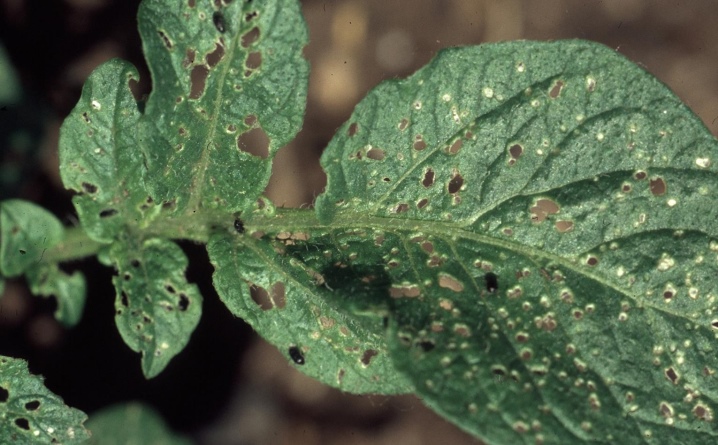
Prevention measures
Preventive measures will help provide the plant with protection from parasites and diseases, as well as identify the problem in time if it occurs.
The first thing to do is to carefully approach the choice of planting material. It must not be damaged. In addition, it is recommended to use for planting those potato varieties that are distinguished by strong immunity.

Plants also need to be inspected regularly in order to notice the problem in time and, if necessary, take the necessary measures. Moreover, if the plant is sick, it is imperative to eliminate the affected parts of it, otherwise the fight against the infection will be meaningless.
Do not forget about quality care. It includes timely watering and top dressing. However, everything should be in moderation. Excess moisture or fertilizer can negatively affect the condition of the plants.
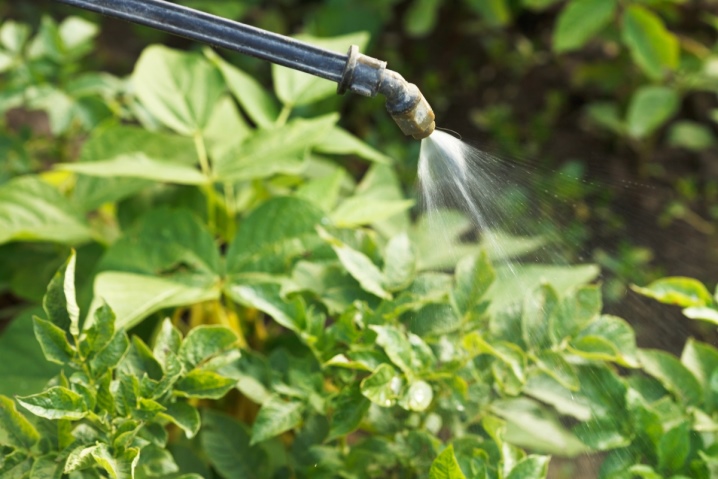
It is also recommended to eliminate weeds, because they are the distributors of harmful insects. Disinfect your garden products regularly. Otherwise, spores of harmful fungi may remain on them, which thus easily pass from diseased plants to healthy ones.
It is worth mentioning the need to harvest the old tops. It must be harvested after the final harvest. Insects with their larvae, as well as spores of harmful fungi, may well remain under the old foliage. The next season, they become more active and begin to precipitate plants.
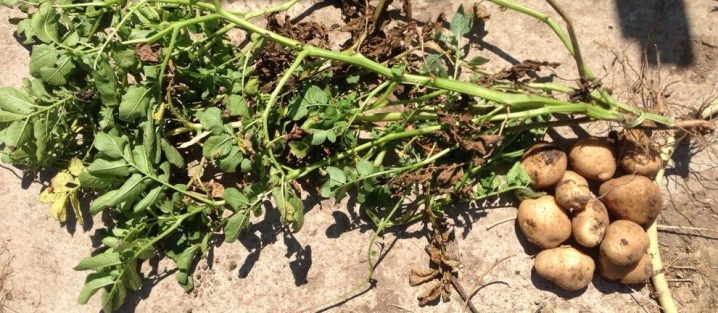





The comment was sent successfully.